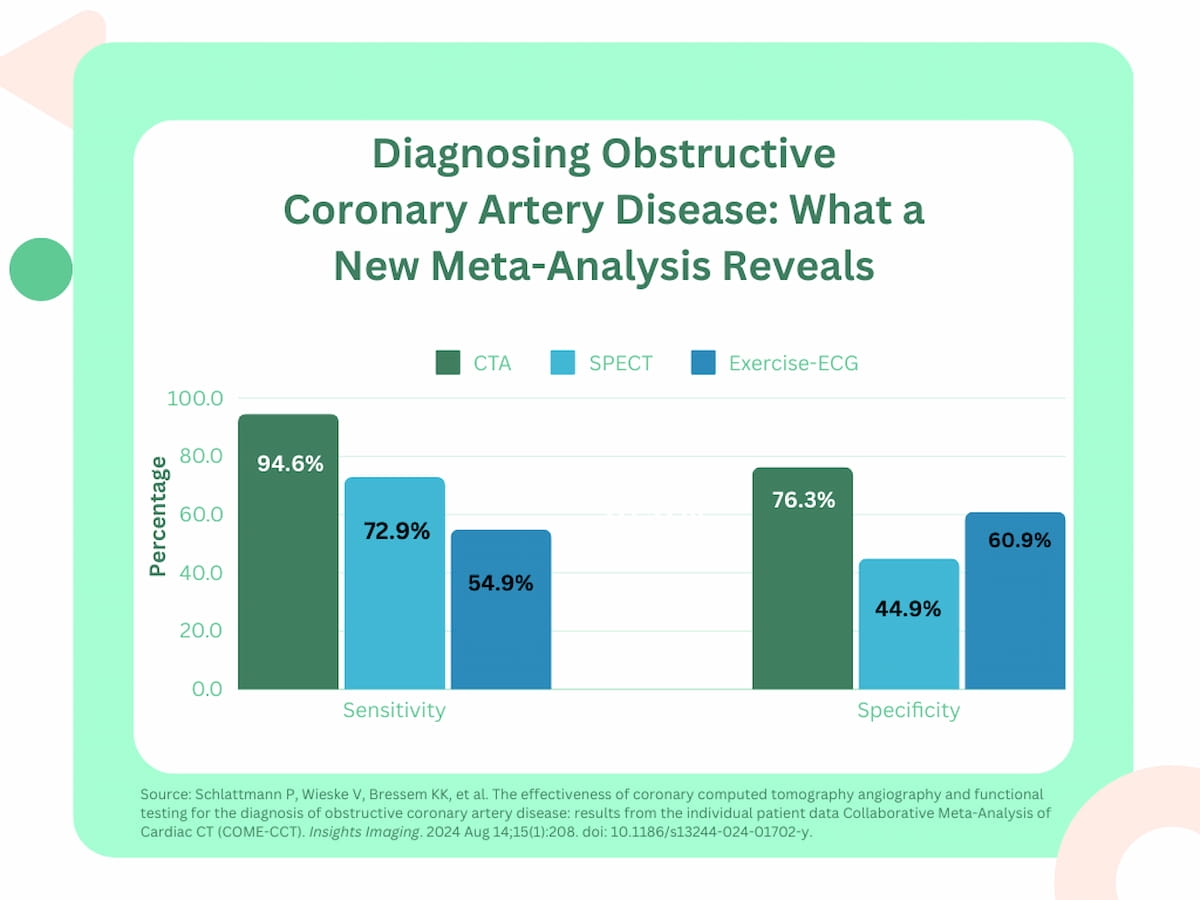Computed tomography angiography (CTA) is significantly more effective than single-photon emission computed tomography (SPECT) and exercise electrocardiography (exercise-ECG) for diagnosing obstructive coronary artery disease (CAD) in patients with stable chest pain, according to a new meta-analysis.
For the meta-analysis, recently published in Insights into Imaging, researchers reviewed data from 31 studies involving a total of 2,920 patients drawn from 16 countries. All patients underwent invasive coronary angiography (ICA), according to the study. The meta-analysis authors noted that men comprised 67 percent of the cohort.
The researchers found that CTA had a pooled sensitivity rate of 94.6 percent in comparison to 72.9 percent for SPECT and 54.9 percent for exercise-ECG for detecting obstructive CAD. Computed tomography angiography also offered a higher pooled specificity rate (76 percent) in contrast to exercise-ECG (60.9 percent) and SPECT (44.9 percent).
“In this pooled analysis of patient-level data, we show that both the sensitivity, as well as specificity of coronary CTA, are higher than that of exercise-ECG and SPECT for the diagnostic assessment of CAD using ICA as the reference standard,” wrote Peter Schlattmann, M.D., Ph.D., who is affiliated with the Institute of Medical Statistics, Computer Sciences and Data Science at the University Hospital of Friedrich Schiller University Jena in Jena, Germany, and colleagues.
Comparing the diagnostic tests at a pretest probability of 10 percent, the researchers found that CTA had more than double the positive predictive value (PPV) of exercise-ECG (50.9 percent vs. 19.1 percent) and was over 18 percent higher than SPECT (32.2 percent).
Three Key Takeaways
1. CTA is superior in sensitivity and specificity. Coronary CTA demonstrates significantly higher sensitivity (94.6 percent) and specificity (76 percent) compared to SPECT and exercise-ECG for diagnosing obstructive coronary artery disease (CAD) in patients with stable chest pain.
2. Higher predictive value. CTA provides a more reliable positive predictive value (PPV) and negative predictive value (NPV) for obstructive CAD compared to SPECT and exercise-ECG, making it a more accurate diagnostic tool across different clinical pretest probabilities.
3. Clinical recommendation. Given the superior diagnostic performance of CTA in this study, the meta-analysis authors said CTA should be widely adopted to assess patients with intermediate pretest probability for obstructive CAD, potentially replacing other forms of cardiac stress testing.
The meta-analysis authors also noted that CTA offers a more reliable option for ruling out obstructive CAD. Computed tomography angiography (CTA) had an 85.2 percent negative predictive value (NPV) for obstructive CAD in contrast to 41.9 percent for exercise-ECG and 34.8 percent for SPECT at a pretest probability of 74 percent, according to the researchers.
“Diagnostic benefits of CTA over cardiac stress testing are seen across a wide range of clinical pretest probabilities and CTA should become widely adopted in patients with intermediate pretest probability,” emphasized Schlattmann and colleagues.
(Editor’s note: For related content, see “Study Offers Closer Look at Patient Preference for CT Angiography Over Invasive Coronary Angiography,” “Five-Year Study Shows Significant Overuse of CT Angiography in the ER” and “Does Initial CCTA Provide the Best Assessment of Stable Chest Pain?”)
In regard to study limitations, the authors pointed out the use of CT scanners with less than 64 detector rows in 14 of the reviewed studies was a contributing factor in reducing CTA sensitivity and specificity rates.
